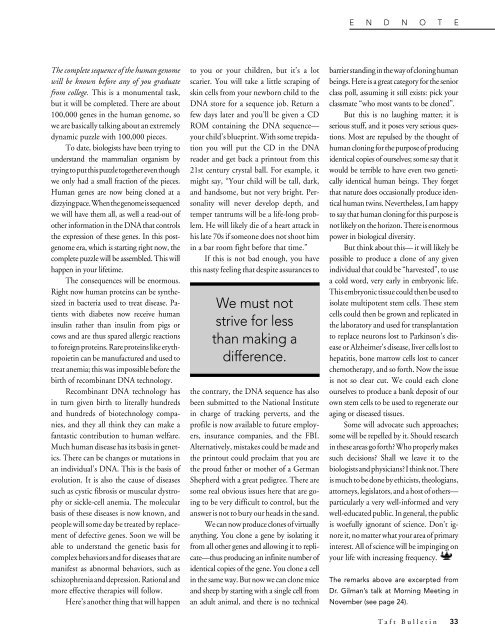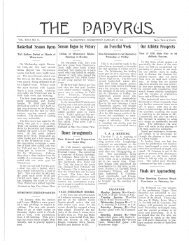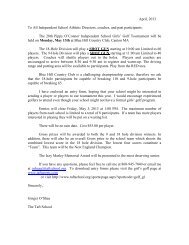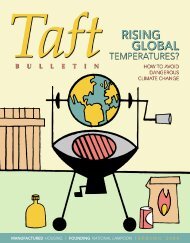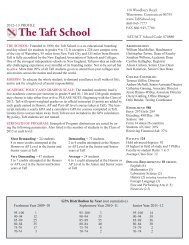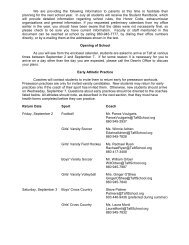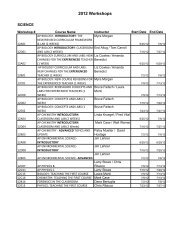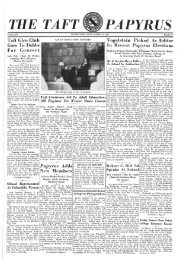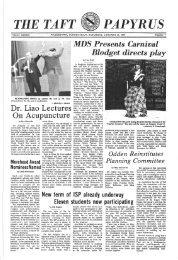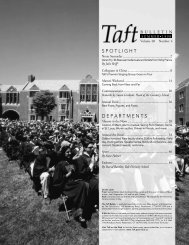S P O T L I G H T D E P A R T M E N T S - The Taft School
S P O T L I G H T D E P A R T M E N T S - The Taft School
S P O T L I G H T D E P A R T M E N T S - The Taft School
Create successful ePaper yourself
Turn your PDF publications into a flip-book with our unique Google optimized e-Paper software.
E N D N O T E<br />
<strong>The</strong> complete sequence of the human genome<br />
will be known before any of you graduate<br />
from college. This is a monumental task,<br />
but it will be completed. <strong>The</strong>re are about<br />
100,000 genes in the human genome, so<br />
we are basically talking about an extremely<br />
dynamic puzzle with 100,000 pieces.<br />
To date, biologists have been trying to<br />
understand the mammalian organism by<br />
trying to put this puzzle together even though<br />
we only had a small fraction of the pieces.<br />
Human genes are now being cloned at a<br />
dizzying pace. When the genome is sequenced<br />
we will have them all, as well a read-out of<br />
other information in the DNA that controls<br />
the expression of these genes. In this postgenome<br />
era, which is starting right now, the<br />
complete puzzle will be assembled. This will<br />
happen in your lifetime.<br />
<strong>The</strong> consequences will be enormous.<br />
Right now human proteins can be synthesized<br />
in bacteria used to treat disease. Patients<br />
with diabetes now receive human<br />
insulin rather than insulin from pigs or<br />
cows and are thus spared allergic reactions<br />
to foreign proteins. Rare proteins like erythropoietin<br />
can be manufactured and used to<br />
treat anemia; this was impossible before the<br />
birth of recombinant DNA technology.<br />
Recombinant DNA technology has<br />
in turn given birth to literally hundreds<br />
and hundreds of biotechnology companies,<br />
and they all think they can make a<br />
fantastic contribution to human welfare.<br />
Much human disease has its basis in genetics.<br />
<strong>The</strong>re can be changes or mutations in<br />
an individual’s DNA. This is the basis of<br />
evolution. It is also the cause of diseases<br />
such as cystic fibrosis or muscular dystrophy<br />
or sickle-cell anemia. <strong>The</strong> molecular<br />
basis of these diseases is now known, and<br />
people will some day be treated by replacement<br />
of defective genes. Soon we will be<br />
able to understand the genetic basis for<br />
complex behaviors and for diseases that are<br />
manifest as abnormal behaviors, such as<br />
schizophrenia and depression. Rational and<br />
more effective therapies will follow.<br />
Here’s another thing that will happen<br />
to you or your children, but it’s a lot<br />
scarier. You will take a little scraping of<br />
skin cells from your newborn child to the<br />
DNA store for a sequence job. Return a<br />
few days later and you’ll be given a CD<br />
ROM containing the DNA sequence—<br />
your child’s blueprint. With some trepidation<br />
you will put the CD in the DNA<br />
reader and get back a printout from this<br />
21st century crystal ball. For example, it<br />
might say, “Your child will be tall, dark,<br />
and handsome, but not very bright. Personality<br />
will never develop depth, and<br />
temper tantrums will be a life-long problem.<br />
He will likely die of a heart attack in<br />
his late 70s if someone does not shoot him<br />
in a bar room fight before that time.”<br />
If this is not bad enough, you have<br />
this nasty feeling that despite assurances to<br />
We must not<br />
strive for less<br />
than making a<br />
difference.<br />
the contrary, the DNA sequence has also<br />
been submitted to the National Institute<br />
in charge of tracking perverts, and the<br />
profile is now available to future employers,<br />
insurance companies, and the FBI.<br />
Alternatively, mistakes could be made and<br />
the printout could proclaim that you are<br />
the proud father or mother of a German<br />
Shepherd with a great pedigree. <strong>The</strong>re are<br />
some real obvious issues here that are going<br />
to be very difficult to control, but the<br />
answer is not to bury our heads in the sand.<br />
We can now produce clones of virtually<br />
anything. You clone a gene by isolating it<br />
from all other genes and allowing it to replicate—thus<br />
producing an infinite number of<br />
identical copies of the gene. You clone a cell<br />
in the same way. But now we can clone mice<br />
and sheep by starting with a single cell from<br />
an adult animal, and there is no technical<br />
barrier standing in the way of cloning human<br />
beings. Here is a great category for the senior<br />
class poll, assuming it still exists: pick your<br />
classmate “who most wants to be cloned”.<br />
But this is no laughing matter; it is<br />
serious stuff, and it poses very serious questions.<br />
Most are repulsed by the thought of<br />
human cloning for the purpose of producing<br />
identical copies of ourselves; some say that it<br />
would be terrible to have even two genetically<br />
identical human beings. <strong>The</strong>y forget<br />
that nature does occasionally produce identical<br />
human twins. Nevertheless, I am happy<br />
to say that human cloning for this purpose is<br />
not likely on the horizon. <strong>The</strong>re is enormous<br />
power in biological diversity.<br />
But think about this— it will likely be<br />
possible to produce a clone of any given<br />
individual that could be “harvested”, to use<br />
a cold word, very early in embryonic life.<br />
This embryonic tissue could then be used to<br />
isolate multipotent stem cells. <strong>The</strong>se stem<br />
cells could then be grown and replicated in<br />
the laboratory and used for transplantation<br />
to replace neurons lost to Parkinson’s disease<br />
or Alzheimer’s disease, liver cells lost to<br />
hepatitis, bone marrow cells lost to cancer<br />
chemotherapy, and so forth. Now the issue<br />
is not so clear cut. We could each clone<br />
ourselves to produce a bank deposit of our<br />
own stem cells to be used to regenerate our<br />
aging or diseased tissues.<br />
Some will advocate such approaches;<br />
some will be repelled by it. Should research<br />
in these areas go forth? Who properly makes<br />
such decisions? Shall we leave it to the<br />
biologists and physicians? I think not. <strong>The</strong>re<br />
is much to be done by ethicists, theologians,<br />
attorneys, legislators, and a host of others—<br />
particularly a very well-informed and very<br />
well-educated public. In general, the public<br />
is woefully ignorant of science. Don’t ignore<br />
it, no matter what your area of primary<br />
interest. All of science will be impinging on<br />
your life with increasing frequency.<br />
<strong>The</strong> remarks above are excerpted from<br />
Dr. Gilman’s talk at Morning Meeting in<br />
November (see page 24).<br />
<strong>Taft</strong> Bulletin 33


